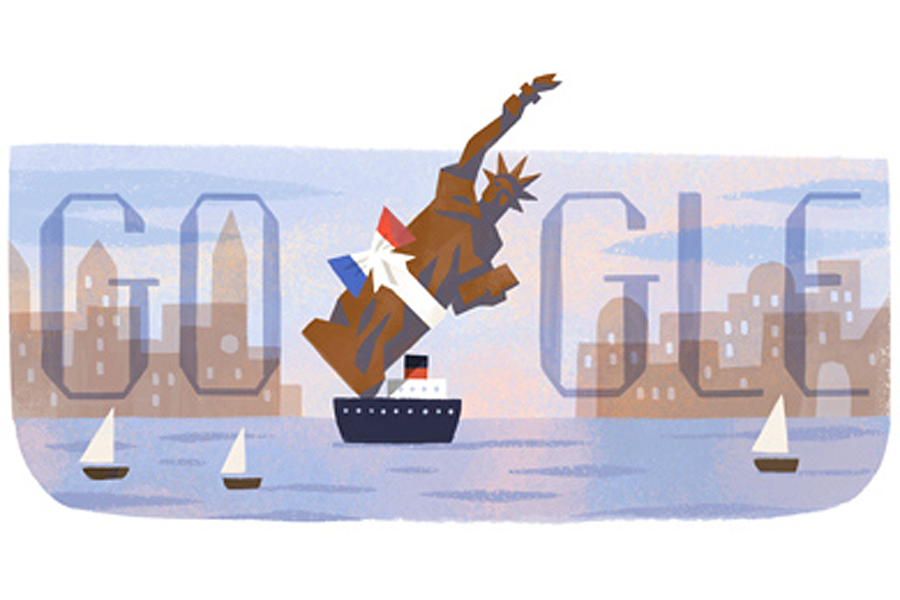How crowdfunding brought the Statue of Liberty to America
Loading...
Isère, the French ship carrying the crates of sculpted metal that would become the Statue of Liberty, pulled in to New York Harbor 130 years ago on Wednesday, and almost a decade behind schedule. The iconic statue faced a twisting and troubled path to the US, which may have derailed the project entirely if not for an ambitious newspaper owner, boxing matches, and France's defeat in the Franco-Prussian War.
This modern colossus commemorates the American Revolution and the partnership with France that helped win the war. The French planned to complete the statue by 1876, in time for the 100th anniversary of the signing of the Declaration of Independence. But political troubles in France and apathy in the US soon threw off that schedule.
While Lady Liberty honored the Revolutionary War, it was actually the Civil War that motivated the gift. Frédéric Auguste Bartholdi, who designed the statue, said that French politician and staunch abolitionist Édouard René de Laboulaye inspired the idea in 1865. At the time, France lived under the rule of the authoritarian Napoleon III. Celebrating American liberty, they thought, would also undermine the monarchy in their own country. Mr. Bartholdi developed early ideas for such a statue, but had to stop amid a resource crunch in France, not to mention his military service during the Franco-Prussian War. Napoleon III lost the conflict, freeing Bartholdi to continue the project once again.
After the war, Mr. Laboulaye sent Bartholdi to the US to scout out locations and drum up support for the statue among influential Americans. Bartholdi had little trouble picking an island – President Ulysses Grant assured him personally that Bedloe's Island (now Liberty Island) would work – but the French sculptor worried that neither Americans nor French seemed too excited about his idea. To get both sides more invested, Laboulaye and Bartholdi cut a deal with the Americans: France would finance the statue if the US secured the rights to Bedloe's Island and paid of the large pedestal beneath the Statue of Liberty.
While many people think of Kickstarter and Indiegogo as modern phenomena, the Statue of Liberty would not exist without crowdfunding. Laboulaye, who after the fall of Napoleon III became a French senator, reached out to regional governments, schools, the owners of copper mines, and the descendants of French soldiers that fought in the American Revolution. By 1880, the French had collected 250,000 francs (more than $5.5 million today).
The Americans, however, had trouble living up to their end of the bargain. To help boost publicity, Bartholdi sent the Statue of Liberty's outstretched arm and torch to Philadelphia for its centennial celebration in 1876. Fundraisers across the country held boxing matches, plays, and auctions to bring in cash, but to little effect. By 1884, the American Committee for the Statue of Liberty ran out of money. Unless something big happened, Lady Liberty would have no place to stand.
With the statue finished and waiting in France, Joseph Pulitzer, founder of the Pulitzer Prize, took it upon himself to raise the money (and sell a lot of newspapers along the way). The New York World, which he owned, launched a massive fundraising campaign that called for small donations from everyday Americans.
"The World is the people's paper, and now it appeals to the people to come forward and raise the money," the World said in March 16, 1885. "Let us not wait for the millionaires to give us this money. It is not a gift from the millionaires of France to the millionaires of America, but a gift of the whole people of France to the whole people of America."
His rallying cry worked. By August, the World collected more than $100,000 ($2.4 million today), mostly from donation of $1 or less.
After months of assembly, the finished Statue of Liberty was dedicated on October 28, 1886. Now, 3 million people visit the statue every year, beholding a gift from France to the US – but also from thousands of regular New Yorkers who, a century ago, came together to give the statue a home.
For more on how technology intersects daily life, follow Chris on Twitter @venturenaut.







